Friuli — discovering Ribolla Gialla and Friulano
May 16, 2013, Updated Jun 28, 2024
This post may contain affiliate links. Read more at our disclosure policy.
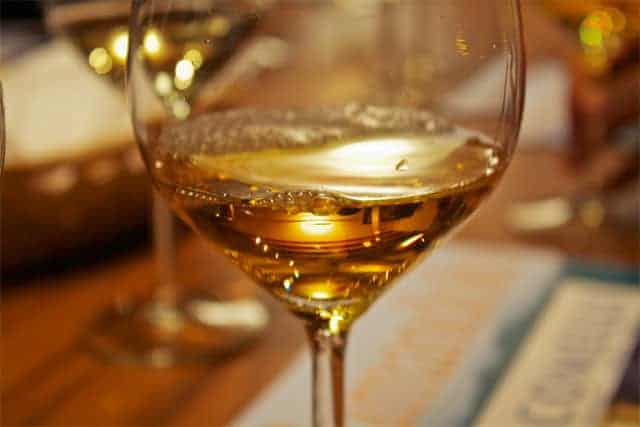
Where to begin with writing about Friuli? The land? The wine? The food? The prosciutto? Oh the prosciutto!
Ok, let’s just start with the wine since there’s no lack of great wine in Friuli-Venezia Giulia. After spending a week in the region I found it difficult to sum up even the wines from here into a few blog posts. There’s a lot of ground to cover even in this small region, so we’re going to start with…
Table of Contents
The Basics – Where is Friuli-Venezia Giulia
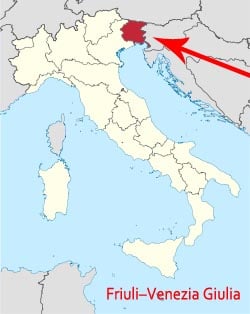
Friuli-Venezia Giulia (Friuli for short), located in Northeast Italy, is one of twenty wine regions in the country. This region (including its wine, cuisine, and culture) is influenced by its Austrian and Slovenian neighbors and nearby Adriatic Sea. This positioning, with mountainous terrain in the north versus maritime conditions towards the coast, gives this region a diverse range of climates and soils for the grapes to grow. The climate further north (where I spent most my time) is influenced by the mountainous Alps, which when it wasn’t raining also offered a ridiculously breathtaking backdrop!
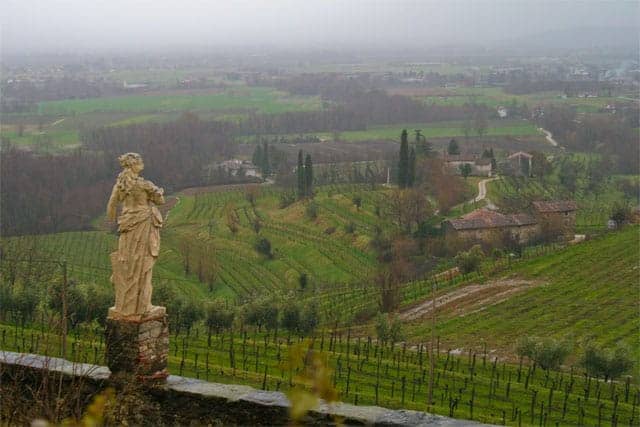

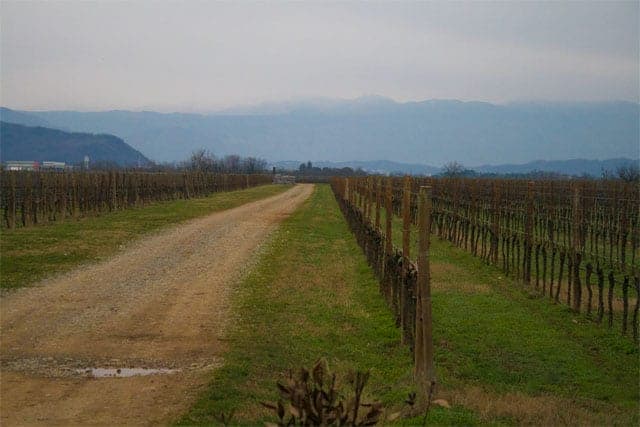
Friuli is home to three DOCG zones, eight DOC zones, and one interregional DOC zone. This region boasts approximately 1,500 vineyards that produce 80 million bottles (roughly 6.5 million cases) a year. Compare that to the entire state of Oregon that produced roughly 1.7 million cases of wine in 2010. Winemakers here produce white, red, sparkling, and dessert wines (though they are most famous for their still white wines).
- DOCG: Ramandolo, Picolit, Rosazzo
- DOC zones within the region: Carso, Colli Orientali del Friuli (where I spent most my time), Collio, Friuli Annia, Friuli Aquileia, Friuli Grave, Friuli Isonzo, Friuli Latisana
- Interregional DOC zone: Prosecco
The grapes that are planted here were originally influenced by Austria (the region was formerly under Austrian empire until the 16th century). By the end of the 16th century Austria started planting international varieties; Pinot Grigio, Pinot Bianco, Chardonnay, etc. Because of this influence the wines here are traditionally named after the grapes, not region, like most other regions in Italy.
With over 30 different grape varieties grown in this region, Friuli is best known for its white wines – a combination of indigenous varieties and also several international varieties such as Pinot Grigio, Sauvignon Blanc, Chardonnay, and Pinot Bianco. There are several notable examples of the aforementioned varieties, however the most memorable for me came from the indigenous Ribolla Gialla and Friulano.
Oh Ribolla, how I love you.
Ribolla Gialla
(Pronounced: ree bowl lah jahl lah) Ribolla Gialla is a white grape variety grown throughout this region. I’ve read it has origins in Greece, but made its home here in Friuli where it is widely planted. You’ll find still and sparkling wines made from 100% Ribolla Gialla, and also blended into other wines.
Rarely found outside this region, you can find very small amounts of Ribolla Gialla grown in CA. I’ve been reading a beautifully written series on Ribolla grown in California on the blog Hawk Wakawaka Wine Reviews. It’s worth a read if you are curious about how this grape does outside Friuli.
Characteristics:
Typically deep in color, it can be a light to medium bodied wine with high acidity. The wines often have a complex bouquet with citrus, floral notes, chestnut, sometimes oak. Those that are aged in oak can be firm and aromatic, and can develop some nutty flavors as they age. Made in both still and sparkling versions these wines can range from being soft, buttery, and velvety but also crisp, lemony, minerally, fresh and bright.
What about food pairing?
This wine can pair with a wide range of foods due to its lemony core and zesty personality that will help refresh the palate between bites. Try with creamy soups or fish dishes or even quiche and frittatas (as you’ll see below).

A few of my favorites:
It should come as no surprise that my favorite examples of Ribolla were the sparkling versions. Ribolla is nice produced as a still wine, but really shines when made into a bubbly. The nose seems to show itself best on the sparkling versions.

Pitars, Ribolla Gialla Spumante Brut, Sparkling Wine
Made in the charmant method with 100% Ribolla Gialla grapes this lovely bubbly was super fresh and fragrant with pineapple, and tropical fruits throughout. The mouth was creamy with mouthwatering acidity. When I asked what the price of this wine was, my jaw dropped when our host Nicola Pittaro (who, BTW, had an uncanny resemblance to Jason Ritter, check it out –>) mentioned it was only 6 euro (!!). If only I could have figured out a way to buy multiple cases to carry home with me. This would have replaced the $8 Cava I use for mimosas in a heartbeat.
Zorzettig had several examples of Ribolla Gialla, including a sparkling version they call “OZ”, made from 100% Ribola Gialla. Also made in the charmant method, this wine was fresh, with bright lemon and lemon peel, crisp and mouthwatering. Only 2,600 bottles (roughly 216 cases) are produced of this bubbly, which means it is very unlikely you’ll run into it in the states, but do keep your eyes out for sparkling Ribolla in general.
Would you like to save this?
Zorzettig Ribolla Gialla, Friuli Colli Orientali DOC, 2011
Dry, crisp, and minerally with high acidity, and lower alcohol.
Pair with fresh fish or serve alongside a frittata like I did at lunch in Friuli one afternoon.
Friulano
Formerly called Tocai Friulano (the name was changed so as to not be confused with Hungary’s Tokaji), Friulano is planted mostly in the foothills of the Alps and is a very popular grape variety in the area. You’ll find wines made from 100% Friulano and also blended into other wines.
Characteristics:
Fruity and floral wines with lively acidity and noted minerality. They are fresh, clean, delicate, smooth, perfumed with aromas of peaches, pears, apples, honeydew, and hints of almonds (which is a quite lovely quality). These wines are crisp, clean, light and lively.
What to munch on while sipping on Friulano?
These are light and fresh wines and go well with light appetizers, soups, and pasta dishes. They are also quite delicious with local prosciutto! Mmmm prosciutto.
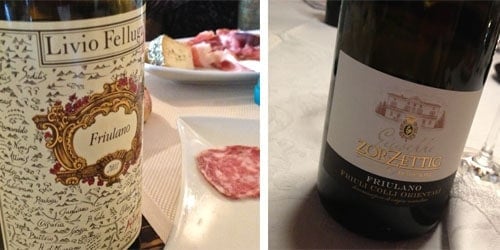
A few examples to be on the lookout for:
Zorzettig Friulano, Friuli Colli Orientali DOC, 2012
I loved the beautiful nose on this wine with loads of juicy stone fruit, lemon, and steely minerality. Crisp and zesty with more roundness then the Ribolla from the same producer (above). This was paired with some local prosciutto that was melt-in-your-mouth soft and was surprisingly well balanced with the Friulano. It was soft like butter, and the wine cut through it like a knife and the fruity flavors sang with the savory meat.
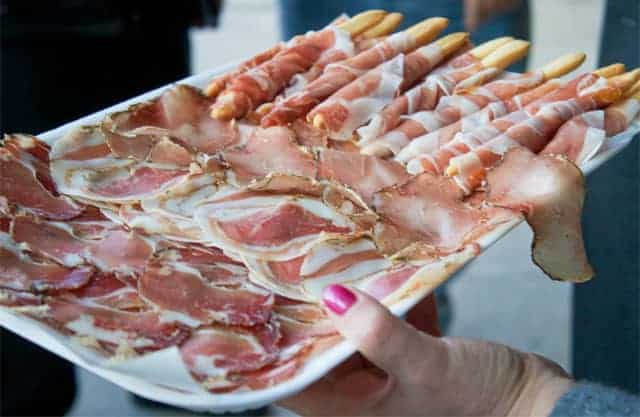
Other excellent examples of Friulano come from Livio Felluga (which you can easily find distributed in the US), Tenuta Fernanda Cappello, and San Simone.
These aren’t the only good wines produced in Friuli, there are tons! This was just the beginning of kicking off the wines of this diverse and delicious region with more to come.
Tell me, have you had either of these varieties or wines with these grapes blended into them? What did you think?
If you haven’t I encourage you to head to your favorite wine shop this weekend and ask about Ribolla Gialla and Friulano. Pick up a bottle or two, taste, learn and enjoy.

Special thanks to the Strada del Vino e Sapori Friuli Venezia Giulia and the IWINETC team for sponsoring this trip.
Related Posts:
A yogurt that is “Better Than Heaven” in Friuli, Italy
I Comelli – An Agritourism Experience
About Vindulge
Mary (a certified sommelier and recipe developer) and Sean (backyard pitmaster) are co-authors of the critically acclaimed cookbook, Fire + Wine, and have been creating content for the IACP nominated website Vindulge since 2009. They live in Oregon on a farm just outside Portland.


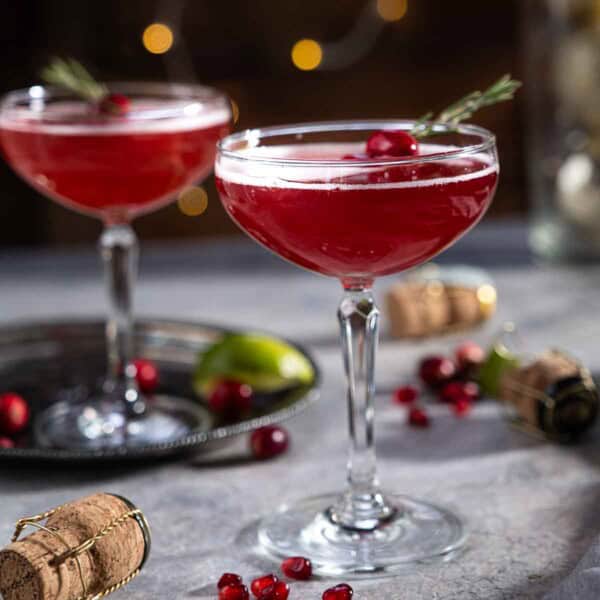




















Where can I purchase Ribolla Gialla, Pinot Grigio, Chardonnay & Sauvignon in the U.S. in particular Houston, Texas?
It was uncanny to rad your article on Rebolla Gialla and Friulano wines while I was having a few glasses of Cormons Ribolla Gialla here in Dallas, TX. I am a Friulano and thought your review was ‘right on the money!’ (Did they give you any local grappas to try, especially with mertilli soaking… :o)
Enjoyed your article!
Thanks so much! No, didn’t try any grapes. It was late winter when I went, so there was none to try. I would love to go back in the late summer or fall sometime though!! Such an incredible region!